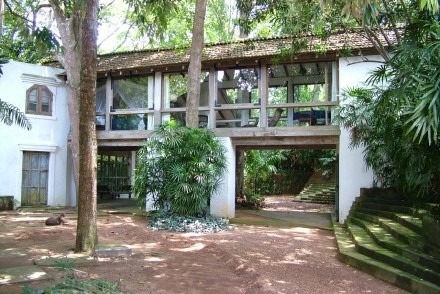TikaWeeks #07/2024: Sri Lanka update
Posted by John on 15th February 2024

As promised, our dedicated Tika Taster to Geoffrey Bawa is now live – Bawa & Architecture. The tour is mostly arranged around visits to or stays in his most iconic buildings but with other architectural highlights thrown in. Visits to the ancient sites of Dambulla, Polonnaruwa and Sigiriya will offer an historical perspective to his work. The 14-day guided trip includes his own town house and country estate, major masterplan projects (new Parliament and University of Ruhuna), hotels, and villas. Your accommodation includes four Bawa-designed hotels to ensure you have the full experience of his design genius.
Geoffrey Bawa is the father of contemporary architecture in Sri Lanka, the creative innovator behind some of the most iconic buildings on the island. Trained as a barrister at the London bar before becoming an architect at the age of 38 years, Geoffrey Bawa developed imaginative and ingenious designs using concepts derived from vernacular Sri Lankan architecture. Beginning with projects for close friends and his own country estate at Lunuganga, Bawa went on to master plan the new Parliament at Sri Jayawardenepura Kotte, the administrative capital of Sri Lanka south of Colombo, and the University of Ruhuna near Matara.
Always a favourite with the island’s hoteliers, Geoffrey Bawa has an impressive and enviable track record for developing novel and inspired designs for hotels and villas, mostly along the country’s western and southern coastlines. He conceived Sri Lanka’s first ever boutique hotel in the early 1970s – Villa Mohotti, now The Villa Bentota – as well as a plethora of resort hotels and villas from Negombo to Tangalle. Visits to and stays in many of his creations are included in this Bawa tour.
Beginning at Jetwing Lagoon in Negombo, the new incarnation of Blue Lagoon Hotel, Sri Lanka’s original resort hotel designed by Geoffrey Bawa, the tour heads up to the Cultural Triangle and a stay at another of Bawa’s unique structures, Heritance Kandalama, Asia’s very first luxury eco hotel, which is hidden amongst natural foliage inhabited by monkeys and birds overlooking serene Kandalama Lake near Dambulla. Travelling south through the Hill Country with overnight stops in Kandy and Ella, the architectural tour continues around the south and west coasts, initially staying at Jetwing Lighthouse close to Galle fort, where Bawa manages to create an atmosphere reminiscent of Moorish palaces, ocean liners, manor houses and colonial villas. The tour finishes at Heritance Ahungalla near Bentota, the refurbished and modified version of Bawa’s original Triton Hotel.
Visits to Bawa-designed town houses and lunch at his former office in Colombo as well as many of his larger projects along the west coast will be complemented by guided tours of the medieval capital of Polonnaruwa, Sigiriya rock fortress and Dambulla cave temples. A tour of the house and gardens at Lunuganga, which were lovingly created over several decades by Geoffrey Bawa as his vision of a tropical garden idyll, is one of the lasting legacies of Asia’s most famous architect.
The ethos behind many of Geoffrey Bawa’s projects was based on sustainable design concepts and traditional construction techniques, particularly regarding natural ventilation and cooling which negated the need for supplementary, artificial air conditioning – The Last House near Tangalle, Bawa’s final design project, was the epitome of this approach which has since had air conditioning installed due to popular demand.
Although a lot of concrete has been used to build his hotel developments, much thought was put into the overall schemes to reduce or avoid tree felling, or unnecessary rock blasting – in the construction of Heritance Kandalama, for instance, no trees were removed and the building forms itself around and over the bedrock and follows the natural topography of the location – or, again, to cool buildings by harnessing the freshening effect of sea breezes, as at The Blue Water in Wadduwa, Heritance Ahungalla and Jetwing Lighthouse. These hotels were also positioned to maximise the effect of the breeze, and designed with tall atria, open elevations and vented public areas to allow the breezes full impact.
Local materials and design hues as well as the history and classical Sinhalese architecture of the island were also close to Bawa’s heart. Although he drew on his vast knowledge of European architecture, Geoffrey Bawa is first and foremost a Sri Lankan architect and his work should be viewed in the context of the geography, people, history and traditions of Sri Lanka. The clay-tiled roofs of traditional walauwas (mansion houses), for example, are emulated in the roof elevations of most of his coastal hotels as well as the various roofs and colonnades of the University of Ruhuna. Samara, a locally-derived ochre pigment, is employed liberally at his various projects, including Jetwing Lighthouse, the original Bentota Beach Hotel (now Cinnamon Bentota Beach) and The Last House. Bawa also preferred native timber to imported wood for his buildings. Seema Malakaya, the only modern Buddhist temple in Sri Lanka to be built to a non-traditional plan and a Bawa project in Colombo in the 1970s, appears to take design themes from the forest monasteries of Anuradhapura and an early ambalama at Panavitiya near Kurunegala.
Categories: Accommodation, Culture, Sightseeing, Sri Lanka, Sustainability
« All articles




